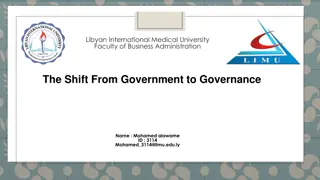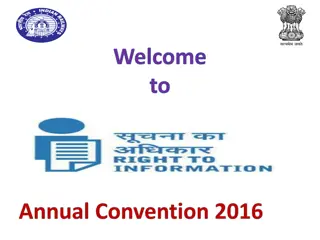Strengthening Accountability and Governance in South Africa's Public Sector
The Auditor-General of South Africa, as the Supreme Audit Institution, aims to enhance public sector accountability and governance to build public confidence. By focusing on shifting public sector culture, they seek to make a significant impact on the lives of citizens by promoting transparency, integrity, and effective government practices.
Download Presentation

Please find below an Image/Link to download the presentation.
The content on the website is provided AS IS for your information and personal use only. It may not be sold, licensed, or shared on other websites without obtaining consent from the author.If you encounter any issues during the download, it is possible that the publisher has removed the file from their server.
You are allowed to download the files provided on this website for personal or commercial use, subject to the condition that they are used lawfully. All files are the property of their respective owners.
The content on the website is provided AS IS for your information and personal use only. It may not be sold, licensed, or shared on other websites without obtaining consent from the author.
E N D
Presentation Transcript
Portfolio Committee on Basic Education 06 May 2023
Mission and vision 2 MISSION The Auditor-General of South Africa has a constitutional mandate and, as the Supreme Audit Institution of South Africa, exists to strengthen our country s democracy by enabling oversight, accountability and governance in the public sector through auditing, thereby building public confidence. VISION To be recognised by all our stakeholders as a relevant supreme audit institution that enhances public sector accountability.
AGSA #CultureShift2030
Our strategic context 4 We have a constitutional and professional mandate as South Africa s supreme audit institution to not just be satisfied with producing reports, but to keep working and persevering in making a difference to the lives of citizens INTOSAI P 12 + Chapter 3 : Section 41 All organs of state must secure the well- being of the people of the republic Public sector audit, as championed by the supreme audit institution (SAI), is an important factor in making a difference in the lives of citizens an independent, effective and credible SAI is an essential component in a democratic system where accountability, transparency and integrity are indispensable parts of a stable democracy + Chapter 3 : Section 41 All organs of state must provide effective, transparent, accountable and coherent government for the republic as a whole + UN Resolution A/RES/69/228 + The ultimate role of an SAI is to make a difference in the lives of citizens Chapter 9 Strengthen constitutional democracy in the republic +
Ourcall to action 5 Having reflected on our South African context and the root causes of the persistent regressive outcomes, we have resolved that in order to see a material change in outcomes, we have to focus on shifting public sector culture Institute of Internal Auditors (IIA) : Practice Guide on Auditing Conduct Risk + Organisational culture and how an organisation comports itself with regard to conduct drives how business is done. It also underlies the effectiveness of the control environment, which supports the achievement of an organisation s objectives. Poor culture and ineffective management of employee conduct has contributed to numerous business failures and has been identified as a root cause of a number of serious issues.
Our strategy 6 We are committing ourselves to making a more direct, consistent and meaningful impact on improving the lived reality of ordinary South Africans over the next seven years + Strategic Aspiration Stronger, more direct and consistent impact on improving the lived reality of ordinary South Africans Today Theory of Change + Sustainably and efficiently shift public sector culture through insight, influence and enforcement Accountability Ecosystem + Illustrative Diagram Broad-based, effective network of stakeholders driving and deepening public sector accountability
Our strategy 7 We are committing ourselves to making a more direct, consistent and meaningful impact on improving the lived reality of ordinary South Africans over the next seven years + Strategic Aspiration 2030 A critical mass of our auditees moved towards cultures characterised by performance, Stronger, more direct and consistent impact on improving the lived reality of ordinary South Africans accountability, transparency and integrity Theory of Change + Sustainably and efficiently shift public sector culture through insight, influence and enforcement Accountability Ecosystem + Broad-based, effective network of stakeholders driving and deepening public sector accountability
Our strategy 8 We are committing ourselves to making a more direct, consistent and meaningful impact on improving the lived reality of ordinary South Africans over the next seven years + Strategic Aspiration Stronger, more direct and consistent impact on improving the lived reality of ordinary South Africans Theory of Change + Sustainably and efficiently shift public sector culture through insight, influence and enforcement Accountability Ecosystem + Broad-based, effective network of stakeholders driving and deepening public sector accountability
STRATEGY 2030 9 We will realise our strategic aspiration by focusing on six strategic goals Shift public sector culture Sustainably Insight Efficiently Influence Enforcement Acquire, develop and maintain the quantity, quality and configuration of people, resources and capabilities to safely achieve and sustain our desired levels of impact Generate audit insights that illuminate understanding, drive action and yield results Unlock latent capacity in the existing resource base and our people and lower the cost and effort with which we derive each marginal unit of quality, insight, influence and enforcement Move stakeholders from mere awareness of our messaging to action on and advocacy of our messaging Move a critical mass of auditees towards organisational cultures charcterised by transparency, integrity and accountability Apply powers to directly and indirectly recover resources lost to the state and taxpayers and ensure application of consequences for wrongdoing
Purpose of Pro-active Reviews 11 PROGRAMME SELECTION Selected programmes linked to the mandate Understand preparation and revision process of updated five- year plans and final draft annual performance plans . Assess the completeness of relevant indicators relating to core functions prioritized for the scoped-in subject matter. REVIEW Assessed the usefulness of the planned indicators and targets 02 01 Enable insights to AO, executive authorities and oversight through discussions of the pro- active findings Determine whether the prior year's material misstatements were considered in new draft plan Assess the measurability, relevance and quality of the indicators and targets planned (per scoped-in subject matter) 03 COMMUNICATE Communicated findings with recommendations to DBE.
SMART TARGETS 12 MEASURABLE RELEVANT Required performance can be measured Required performance is linked to achievement of goal S M A R T SPECIFIC ACHIEVABLE TIME BOUND Nature and required level of performance can be clearly identified Time period/deadline for delivery is specified Realistic given existing capacity .
Characters of good performance indicators 13 Well defined Clear, unambiguous definition so that data will be collected consistently and will be easy to understand and use Reliable Must be accurate enough for its intended use and respond to changes Cost-effective Usefulness of the indicator must justify the cost of collecting the data Verifiable Possible to validate the processes and systems Good performance indicators Relevant Must relate logically and directly to an aspect of the institution's mandate Appropriate Avoid unintended consequences and encourage service delivery improvements
Key programmes and indicators 14 Teachers, Education Human Resources and Institutional Development Planning, Information and Assessment 4 3 2 Curriculum Policy, Support and Monitoring Key Indicators: Key Indicators: Key Indicators: 4.1.1 Number of new schools built and completed through ASIDI. 2.1.3 Number of Children/ Learners with Profound Intellectual Disability (C/LPID) using the Learning Programme for C/LPID. 3.1.3 Number of Funza Lushaka bursaries awarded to students enrolled for Initial Teacher Education per year. 4.1.2 Number of schools provided with sanitation facilities. 2.1.5 An Annual National Report is produced on the development of a new funding model for ECD. 4.1.3 Number of schools provided with water facilities through ASIDI. 3.1.4 Number of quarterly monitoring reports tracking the percentage of Funza Lushaka graduates placed within six (6) months upon confirmation that the bursar has completed studies. 2.3.2 Percentage of public schools with Home Language workbooks for learners in Grades 1 to 6 per year, after having placed an order. 3.1.5 An Annual National Report is produced on the number of qualified teachers aged 30 and below entering the public service as teachers. 2.3.3 Percentage of public schools with Mathematics workbooks for learners in Grades 1 to 9 per year, after having placed an order. 2.3.4 Percentage of public schools with workbooks for learners in Grades R per year, after having placed an order.
Observation on usefulness of indicators 15 Measurability: Performance indicators are well defined and verifiable, and targets are specific, measurable and time bound: A performance indicator is well defined when it has a clear definition so that data will be collected consistently and is easy to understand and use. A performance indicator is verifiable when it is possible to validate or verify the processes and systems that produce the indicator. A target is specific when the nature and required level of performance of the target is clearly identifiable. A target is measurable when the required performance can be measured. A target is time bound when the timeframes for achievement of targets are indicated. Performance indicators not well defined Some output indicators were not clearly defined and not specific i.e the technical indicator definitions (TIDs) were not clear. Targets not specific The TID did not specify the period covered by the target set The set target did not specify the level of official to approve the achieved deliverables Enable insights to AO, executive authorities and oversight through discussions of the pro- active findings The TIDs provide important details that facilitates the measurability and verifiability of indicators and targets. It is important that the TID adequately supports the reliable reporting of the indicators and targets. Performance indicators were not verifiable For some indicators, the means of verification were not clear and not complete on the TIDs Definition of indicators were not aligned to the method of calculation An output indicator was not verifiable as it was possible to validate or verify the processes and systems that produce the indicator. We have raised observations related to measurability of indicators and targets set by the department on the following scoped-in programmes: - Programme 3: Teachers, Education Human Resources and Institutional Development Programme 4: Planning, Information and Assessment Programme 5: Educational Enrichment Services - -
Observation on completeness of indicators against MTSF 16 MTSF 3: Education, Skills and Health 03 Number of unemployed youths trained in an accredited course in general maintenance of school buildings Digitised text book Education facility management system is developed at Provincial level MTSF 4: Consolidating the Social wage through reliable and quality basic services Percentage of indigent women and girls in quintile 1, 2 and 3; farm schools and special schools; TVET colleges and public universities receiving free sanitary towels MTSF output indicators MTSF output indicators that were not included in the APPs of the departments 04 MTSF 6: Social Cohesion and Safer Communities Distribute an annual circular statement to all 9 provinces to inculcate the culture of recital of the Preamble of the Constitution at all school assemblies and gatherings Number of Programmes that promote history, culture and national heritage Revise History Curriculum and Assessment Policy Statement for Grades 4-9 Revise History Curriculum and Assessment Policy Statement for Grades 10-12 Conduct master training for History Curriculum Specialists in each province on the revised History Curriculum Develop exemplar question papers on the revised History curriculum for Grades 10-12 Conduct training for History examiners on the revised History Curriculum for standardization of Grade 12 examination 06 If department exclude indicators from their annual performance plans, they risk not being able to achieve the MTSF indicators targets as well as the priority goals. This means the administration may not be able to deliver on its promised services and improve the quality teaching and learning in South Africa. A target that is not measured or accounted for, is unlikely to be delivered
18 1. Implement suitable risk management 1. A demonstrated commitment to integrity and ethical values 2. Establish and communicate policies and procedures 2. Accounting officers and authorities provide independent oversight 3. Demonstrate commitment to competence 3. Building and maintaining a strong control culture 4. Use assessments of independent assurance providers 4. Implementing effective consequences 1. Use procurement plans to enable proper planning 2. Ensure adequate capacity and skills for supply chain management 3. Implement standardised, effective procurement processes 4. Safeguard against conflicts of interest
19 1. Ensure adequate capacity and skills to perform accounting and reporting activities 1. Keep proper records of assets and perform conditional assessments 2. Implement standardised, effective accounting processes 2. Implement controls to safeguard and maintain assets 3. Ensure segregation of duties in management of assets 3. Ensure proper record keeping and document control 4. Independently review and reconcile accounting records 5. Carry out in-year reporting and monitoring 6. Perform timely and accurate year-end reporting and monitoring
20 AVAILABLE RESOURCES Reports available on our website Report on the material irregularities identified and their status RESOURCES Preventative control guidelines available on our website 1. Importance of preventative controls 2. Tone and control culture 3. Institutionalised internal controls 4. Procurement of goods and services 5. Preparation of financial statements 6. Asset management 7. Infrastructure delivery process www.agsa.co.za
Some key areas the committee may consider when reviewing the APP 21 NDP Are the indicators and targets set by the department aligned with the expectations of the committee and strategies of government? With the limited fiscus, will the target set achieve the maximum impact in relation to the mandate? MTSF #Cultureshift Action Plan 2024 Are there systems in place to enable achievement? Will the targets achieve the best results for the citizens DBE SP/APP 21
We recommend to the committee 22 INCLUSION OF MTSF INDICATORS 1 The committee monitor the inclusion of the MTSF indicators in the APP of the department The committee implement the accelerated interventions for realisation of MTSF aspirations. MONITORING OF APPs 2 The committee to monitor the progress made on implementation of the APP and assess the impact of the non-achievement has on service delivery.























